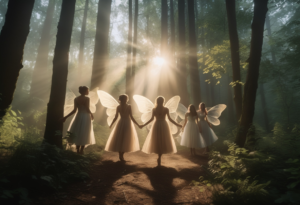
The Wheel of the Year is a concept central to many pagan traditions. It represents the cyclical nature of life and the seasons, reminding us that everything has its own ebb and flow. The eight holidays associated with this wheel, also known as Sabbaths, mark significant points in the yearly cycle, each holding its own unique energy and meaning. In this piece, I will provide a brief overview of each holiday, followed by a suggested ritual for honoring their significance.
Samhain (October 31st) Samhain marks the end of harvest season and the beginning of winter. It is traditionally celebrated as a day when the veil between our world and the spirit realm thins, allowing us to connect more deeply with our ancestors and those who have passed over into the next realm. Ritual: Light candles and incense in honor of loved ones who have departed. Place photographs of them around the altar space, and spend some quiet time meditating and connecting with their memories.
Yule (December 21st) Winter solstice, Yule celebrates the rebirth of the sun after three months of darkness. It is a time to embrace the light within ourselves, despite the harshness of winter. Ritual: Decorate a tree or other natural object with lights, symbolizing the return of the sun’s rays. Sing carols and songs of hope and renewal, while burning spices like cinnamon, clove, and nutmeg to ward off negativity.
Imbolc (February 1st/2nd) Celebrated as Candlemas, Imbolc marks the halfway point between Winter Solstice and Spring Equinox. It is a time to honor the maiden aspect of the goddess, and her ability to nurture growth and fertility. Ritual: Create a candle made from wax melts of lavender, rosewater, and lemon essential oils. Use this candle during meditation to invoke the energies of purity, clarity, and rejuvenation.
Ostara (March 20th/21st) Spring equinox, Ostara, represents a time of balance and equality between night and day. It is a time to celebrate the awakening of nature and the resurrection of life. Ritual: Gather wildflowers and place them in a vase filled with water. Set them aside as offerings to the earth, and spend time reflecting on the cycles of life, death, and rebirth.
Beltane (May 1st) Celebrated as May Day, Beltane honors the union of male and female principles. It is a celebration of fertility, love, and sexuality. Ritual: Build a bonfire and jump through its flames, symbolically shedding old patterns and welcoming new beginnings. Dress up in flowers, greenery, and colorful fabrics to represent the beauty of spring.
Litha (June 20th/21st) Summer solstice, Litha, commemorates the longest day of the year. It is a time to celebrate abundance, joyfulness, and vitality. Ritual: Make a wreath out of fresh leaves, berries, and twigs. Hang it above the doorway or window, inviting positive energy and good luck into one’s home.
Lammas (August 1st) Also called Lammas Day or Loaf Mass, Lammas marks the first harvest of the summer. It is a time to honor the fruitfulness of nature and give thanks for the bounty provided by the earth. Ritual: Prepare bread dough infused with honey, wheat, and salt. Offer it to the gods and goddesses as a gesture of gratitude and respect.
Mabon (September 21st/23rd) Autumn equinox, Mabon, signifies the transition from light to dark. It is a time to acknowledge the need to let go of what no longer serves us and prepare for the coming winter. Ritual: Collect autumn leaves and arrange them in a pattern representing a mandala or labyrinth. Walk through it slowly, meditating on the lessons learned throughout the year.
In conclusion, the Wheel of the Year provides a framework for connecting with the cycles of nature and the deeper aspects of our psyche. By acknowledging the changing seasons, we become more aware of the ebbs and flows of life itself. Through these rituals, we honor the sacredness of our experiences and cultivate a deeper sense of reverence for the world around us. Whether alone or in community, these practices offer opportunities for reflection, renewal, and transformation. May they serve as a source of inspiration and guidance as you embark upon your own spiritual journeys!
The Wheel of the Year is a concept rooted in ancient pagan traditions, specifically in Celtic culture. It involves celebrating eight festivals, known as Sabbats, which mark significant moments in the annual cycle of seasons.
These festivals include four solar festivals, such as Winter Solstice, Spring Equinox, Summer Solstice, and Fall Equinox, as well as four seasonal festivals that commemorate significant shifts in the seasons. The exact origins of the Wheel of the Year are unclear, but it is evident that similar celebrations were observed by ancient Celts, albeit under different names.
As Christianity gained prominence, many of these traditional customs and beliefs were assimilated into Christian practices. However, the cyclical nature of time and the importance of tracking the change of seasons continue to be acknowledged in contemporary pagan traditions, including Wicca, Celtic religions, Druidism, Dianic, Anglo-Saxon, or Secular traditions.
The Wheel of the Year is typically represented by a circular or wheel-shaped symbol, highlighting the cyclical nature of birth, decline, and death, as experienced in human life and in the recurring natural cycle. Overall, the Wheel of the Year remains a crucial element in many pagan traditions today, serving as a focal point for tracking the passage of time and celebrating the cyclical nature of life and the seasons.






